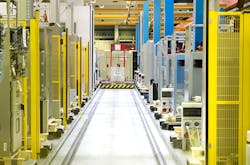When ABB, Zurich, Switzerland announced its acquisition of GE Industrial Solutions (GEIS), Plainville, CT, in Sept. 2017 for $2.6 billion, few electrical distributors doubted its intentions to use the deal as a platform to expand in the U.S. market in a big way. Over the past decade, ABB had already bought Thomas & Betts (T&B), Memphis, TN, for $3.9 billion in 2012, and Baldor Electric, Fort Smith, AR, for approximately $4.2 billion in 2010. Since ABB bought these businesses, it has invested steadily in its U.S.-based manufacturing facilities.
Buying Baldor brought one of North America’s premier motor manufacturers into its stable of brands, and T&B gave it access to a U.S. distributor network of an estimated 6,000 branches, as well as the dozens of electrical brands that T&B itself had purchased over the years.
The GEIS acquisition also substantially increased its presence in the U.S., as before the T&B deal, ABB said its sales mix in its Americas region was approximately 9% of total corporate revenues. Today, the region accounts for 29% of the company’s total revenues, which in 2018 were approximately $27.6 billion. A big chunk of those sales flow through ABB’s Electrification Business, which has estimated sales of $12.8 billion and includes large portions of the integrated T&B and GEIS businesses.
While the big sales numbers are impressive, the story behind ABB’s expansion into the U.S. market offers better insight into what makes the company tick, and how the GEIS deal and other acquisitions fit into its growth plans. The integration of GEIS into ABB is about one-third complete, but 13,000 GEIS employees have already transitioned to ABB and the company has started expanding some of its facilities in the U.S. Plans for the closure of 13 GEIS facilities have been announced, but the company is also investing $480 million in other plants, including $39.9 million in advanced manufacturing techniques for its Mebane, NC, facility, and $36 million in these processes for its Senatobia, MS, factory.
During ABB’s recent Electrification Media Day in Bergamo, Italy, which was attended by more than 20 business journalists from nine countries, ABB executives said one of the main reasons the company bought GEIS is that the product lines of the two companies did not overlap very much, in part because ABB had a focus on products built to IEC standards, while GEIS focused on products built to ANSI standards.
Another difference between the two businesses was the level of R&D investment in recent years. ABB has invested $400 million in R&D over the past five years to keep pace with new digital technologies, such as IoT-enabled electrical products and systems with initiatives like its ABB Ability marketplace. In contrast, the GEIS business had been under-funded in this area, according to ABB executives and other industry sources. Industry observers agree that while GEIS was one of the electrical market’s best-known brands, with all the changes at GE corporate, it was not getting this level of investment to update its product offering or factories and keep pace with the new technologies flooding the industry.
At ABB’s Electrification Media Day, Electrical Wholesaling visited with Maryrose Sylvester, ABB’s U.S. head of Electrification, and Mike Mustapha, head of global markets, to discuss ABB’s distribution strategies and 2020 growth initiatives. Both stressed the role that electrical distributors play in the company’s growth plans. Distributors account for an estimated 75% of the company’s sales in the United States and approximately 50% of its global sales, making them integral partners in the company’s future growth plans. Sylvester said sales through electrical distributors “are not adjacent to our market. It is our market.”
Sylvester and Mustapha also spoke about the role distributors will play in next year’s launch of solid-state circuit breakers, NeoGear switchgear and related equipment. Right now, the company’s field applications engineers are working with engineering firms and other end users to switch over specifications for many GEIS products to ABB products. The company will also be training electrical distributors on how to sell the new products and specifications. “Immediate reaction from customers is overwhelmingly positive,” Sylvester said. “Many of our channel partners and end users were doing business with GE for a long time. They had a legacy product line. ABB has such a track record as a technology leader, and we (GE) knew we had a gap in the U.S.
“In terms of the substitution, we have a whole team of field application engineers working with customers that were ‘speced’ in on GE. Every one of those will eventually be switched to the new ABB spec. We are taking those one at a time. It has been very positive, but it’s been a process. They need to get the designs locked down, test them and qualify them. A lot of it right now is preparation, but people are ready to move forward.
She says “seeding the market” for these products and getting the word out about ABB’s U.S. presence are key strategies. “It’s getting to the end users and the contractors and letting them understand where we are going with our technology and letting them understand the benefits.”
“The big message is ABB is investing in the U.S. We are investing in manufacturing sites and in our commercial presence and are making sure we have the right application engineers out helping them get our products specified. GEIS now has a new owner that’s here for the long term and is committed to the marketplace.”
About the Author
Jim Lucy
Editor-in-Chief of Electrical Wholesaling and Electrical Marketing
Jim Lucy has been wandering through the electrical market for more than 40 years, most of the time as an editor for Electrical Wholesaling and Electrical Marketing newsletter, and as a contributing writer for EC&M magazine During that time he and the editorial team for the publications have won numerous national awards for their coverage of the electrical business. He showed an early interest in electricity, when as a youth he had an idea for a hot dog cooker. Unfortunately, the first crude prototype malfunctioned and the arc nearly blew him out of his parents' basement.
Before becoming an editor for Electrical Wholesaling and Electrical Marketing, he earned a BA degree in journalism and a MA in communications from Glassboro State College, Glassboro, NJ., which is formerly best known as the site of the 1967 summit meeting between President Lyndon Johnson and Russian Premier Aleksei Nikolayevich Kosygin, and now best known as the New Jersey state college that changed its name in 1992 to Rowan University because of a generous $100 million donation by N.J. zillionaire industrialist Henry Rowan. Jim is a Brooklyn-born Jersey Guy happily transplanted with his wife and three sons in the fertile plains of Kansas for the past 30 years.

